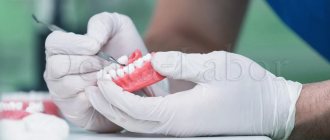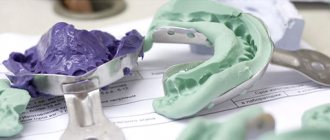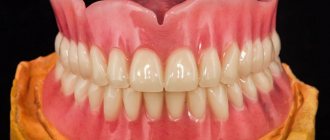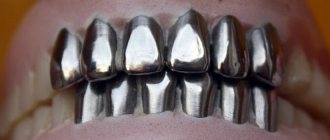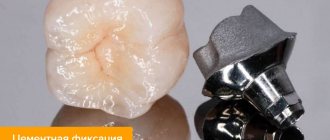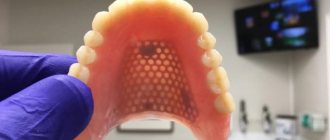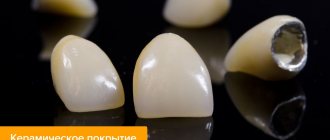- Indications
- Contraindications
- Advantages and disadvantages
- Kinds
- Clasp
- Made from nylon
- Lamellar
- Immediate dentures
- Manufacturing and installation
- Rehabilitation
- Care
- Prices
- Work examples
- Doctors
- Reviews
Despite the variety of implants, crowns and other methods of dental reconstruction, removable prosthetics does not lose demand, remaining an option for patients. Lightweight and strong structures compete with permanent dentures. This is a choice in cases where the patient cannot undergo implantation or have a fixed orthopedic system installed.
- When used:
missing from 1 tooth to completely edentulous - Type of anesthesia:
no need - Procedure time:
from 30 minutes (up to 4 visits) - Treatment period:
from 1.5 weeks to 3 weeks - Healing period:
from 3 weeks after the last removal - Age restrictions:
from 18 years old (in our clinic)
What dentures are best?
The type of system is selected individually. Taking into account the pros and cons of the designs, we draw the following conclusions:
- In case of partial loss of teeth and the presence of supporting teeth, clasp dentures will be an option. If there is an allergy to metals, choose QuattroTi dentures, acrylic, nylon models.
- If you have a toothless jaw, intolerance to acrylic and the impossibility of implantation, use plate Acry Free or nylon analogues.
Clasp dentures from 40,000 rub.
Nylon prostheses from 40,000 rub.
Lamellar dentures from 32,000 rub.
Butterfly prosthesis from 11,000 rub.
Quadrotti prosthesis from 64,500 rub.
Acri-Free prostheses from 47,000 rub.
Even with the same dental defects in two patients, prosthetics proceed differently. Only a doctor can tell which orthopedic product is the decision in this clinical situation, after examination and x-rays.
Fixed dentures:
Fixed dentures allow you to achieve high aesthetic and functional results. These dentures are the most comfortable and after a short time patients perceive them as their own teeth. Caring for these dentures is practically no different from your own teeth.
Fixed dentures include
- microprostheses: inlays, veneers, lumineers, these are prostheses that allow you to replace part of the crown of a tooth in order to restore it or improve the aesthetics of the tooth. For the manufacture of these prostheses, pressed ceramics are used, from which the frame is made and ceramic mass is applied on top
- crowns: this is a highly aesthetic and fully functional design that allows you to completely restore the coronal part of the tooth. And if it is necessary to improve aesthetics, change the shape of the tooth crown. These prosthetics include crowns and bridges on your teeth and on implants. If the tooth is destroyed by more than ⅔, then pin-stump inlays are made to restore the missing volume of tissue. They are made from cobalt-chromium alloy or zirconium dioxide
The materials for the manufacture of crowns and bridges are metals: cobalt-chromium alloys, nickel-chrome alloys, titanium, gold. Metal-free materials are also used: zirconium dioxide, pressed ceramics, feldspar.
Metal-ceramic crowns
- These are crowns consisting of a cast or milled metal cap and ceramic mass. After applying the ceramic, the crowns are baked in special vacuum ovens at temperatures up to 1000°C. These dentures completely imitate your teeth. They are durable and comfortable. The patient quickly gets used to them and begins to perceive them as his own teeth. The color of the future crown is selected according to the color of the patient’s teeth, so that they do not differ from their own teeth. There are a number of disadvantages to these crowns: they are not suitable for patients with allergies to metals. Over time, the edge of the crown near the gum begins to darken and this indicates oxidation of the metal; the edge of the gum adjacent to the crown may turn dark. There is also one nuance with aesthetics. If the patient does not have transparent enamel, then metal ceramics are ideal. But if the enamel is transparent, then the crown will stand out from the rest of the teeth. This is due to the fact that the technician, trying to hide the metal cap under the ceramic, applies non-transparent layers in the lower third of the crown, and when its thickness at the edge is less than a millimeter, the ceramic layer turns out to be thin and not transparent. The ability of such a crown to transmit light in the lower third is significantly different from its teeth and the tooth appears dull, not alive. Such crowns can be placed on chewing teeth where aesthetics can be neglected in favor of savings. It is better to place crowns of a higher class on the front teeth.
Crowns based on zirconium dioxide.
These crowns are precisely the next step in the evolution of orthopedic dentistry. In these crowns, the material used to make the cap is not metal, but the mineral zirconium dioxide. And it is also applied on top with ceramic mass and fired in a kiln. But, unlike the metal cap, it is transparent. And it can be given whatever color is needed to completely imitate the internal structure of the patient’s teeth. Since zirconium dioxide does not need to be hidden, the technician applies layers of ceramics that are as close as possible in terms of light transmission to the patient’s enamel and dentin. And as a result, we get a fantastic imitation of a living crown that is no different from the patient’s other teeth. In addition, such crowns are devoid of other disadvantages of metal-ceramics. Zirconium dioxide does not oxidize and does not darken along the edge even after 15 years. Previously, such crowns were made only abroad and cost exorbitant amounts of money. Since the technology for milling zirconium caps and bridge frames is quite complex and is produced using expensive equipment. Now all this exists in Russia. The prices for these crowns have become much more affordable and they cost slightly more than metal-ceramics.
Advantages and disadvantages
Advantages
- Restoring the aesthetics and functioning of the dentition;
- used in complex clinical situations when reconstruction methods are impossible;
- selection of types of orthopedic products;
- installation without preliminary grinding of abutment teeth;
- variability of materials for manufacturing;
- without restrictions;
- speed of production and installation;
- repair of the orthopedic system in case of mechanical damage;
- ease of wearing and care;
- exceptional hygiene and safety;
- no age restrictions;
- use as a temporary prosthetic structure;
- service life (5-8 years);
- preservation of aesthetic indicators;
- price.
Flaws
- Restoration of chewing function is not complete;
- changes in diction, taste sensitivity during the period of adaptation;
- the likelihood of gum inflammation, irritation of the oral mucosa;
- uneven distribution of chewing loads;
- unable to stop or prevent jawbone atrophy;
- not all types of dentures and fixtures can be repaired;
- risk of damage to tooth enamel, development of cervical caries in the area where the attachments adhere to the supporting ones;
- relatively long period of adaptation;
- deformation and subsidence of the product (for metal-free structures);
- insufficient fastening on the lower jaw (applies to complete removable dentures).
Contraindications
Dental prosthetics with suction cups have few contraindications.
Relative
the procedure can be carried out with extreme caution
- inflammation of the gums;
- systemic infections, including acute respiratory infections, acute respiratory viral infections;
- acute stages of any disease.
Absolute
the procedure is strictly prohibited
- Allergy to material;
- mental disorders;
- malignant processes of the oral cavity, accompanied by destructive changes in the periodontium and jawbone.
Types of removable denture systems
Removable dentures – orthopedic products. They are removed and installed in the oral cavity independently. Dentures are made from biocompatible, elastic materials. Two kinds:
- Partial removable - installed if the patient is missing one or more in a row. These are plate, clasp, and immediate dentures. They are attached to supporting teeth or implants with fixing elements. Evenly distribute the load when chewing between the supports and gums.
- Full removable – in case of loss of teeth on one or both jaws. In such situations, it is impossible to secure the denture to a rigid support. Alternative fixation is used. The chewing load is placed on the gums.
Modern technologies provide strong fixation and precise fit to removable orthopedic systems. Patients note the ease of use and care.
How to install prostheses - stages of prosthetics
After the patient has been diagnosed and is fully prepared, prosthetic procedures begin, which will result in the restoration of lost teeth and a smile transformation. All of them are painless and do not take much time. Below is a description of all stages of dental prosthetics.
Sanitation of the oral cavity
It is a mandatory preparatory stage before prosthetics. Sanitation aims to improve the overall health of the oral cavity and reduce the bacterial load. It includes treatment of living teeth from carious lesions, elimination of inflammatory gum diseases, if necessary, depulpation - removal of the nerve from the tooth, canal filling, as well as a complex of professional hygiene. All this is necessary to create favorable conditions1 before future prosthetics.
PROSTHETIC PROSTHETICS WITH 4 STRAUMANN IMPLANTS “teeth in 1 day” - RUB 220,000. until January 15, 2022!
Complex implantation using ProArch technology (Switzerland) with immediate loading on the day of surgery!
Call now or request a call
For more information about dental treatment before installing dentures, read the article “Preparation for dentures: steps and procedures for successful dental restoration and long-term denture service.”
Photometry
A series of photographs of the patient's face and jaw are taken from different angles. The photo captures the patient's face with and without a smile, with jaws closed, in a relaxed state and with an open mouth. This is necessary to visually assess changes in occlusion, facial symmetry caused by missing teeth, as well as to record the patient’s “before” appearance. Later, the final result of the prosthetics will also be recorded in the photo and will determine the “after” result.
Taking impressions of the jaws
To create an accurate design, first complete impressions of the upper and lower jaw with the defect area are formed on a special pliable mass. If teeth are restored with complete edentia, then impressions of the gums are made. With their help, the base of the prosthesis and the structure itself are formed, taking into account the bite. For this purpose, devices such as analyzers and face bows are needed. They help to identify the parameters of bite and jaw closure - occlusion, which is of great importance for functionality and organic integration of the structure into the oral cavity.
This way, all the anatomical features of the patient will be taken into account - they are unique for each person. The impressions are sent to a dental laboratory, where a dental technician will evaluate the features of the prosthetic bed, the location of the defect, and take into account the shape and size of adjacent teeth.
Choosing a prosthesis model, teeth shape and color
Based on the diagnostic results, the doctor advises the patient several prosthetic options suitable for his clinical case. The shape and color of the teeth are immediately selected, harmoniously combined with facial features and skin tone. The choice can be made using special palettes, where possible options are presented, or on the monitor screen (if provided) - that is, in digital format. For example, through special software - we will discuss it below.
Digital Design and Planning
Some modern clinics, which have advanced methods of planning and creating dentures, offer their patients to see their future smile in advance and finally decide on their choice. For this purpose, digital smile design technology is used – Digital Smile Design. It allows, based on computed tomography data, to take into account all the anatomical nuances of the patient’s oral cavity even before making the prosthesis and create an artificial structure indistinguishable from natural teeth.
Thanks to the ideal selection of the shape of the teeth and jaw as a whole, taking into account the relationship and proportions of the face, the patient will receive an individually designed prosthesis. The principles of the “golden ratio” and “beauty mask”, embedded in computer modeling, allow you to correct your smile, creating truly harmonious and natural designs.
Creating a prosthesis in a dental laboratory
In the dental laboratory, the impressions obtained are transferred to plaster models - exact copies of the patient's jaws. And on their basis, with the help of special equipment and from various materials, prosthetics are already created. It is possible to manufacture a structure from both acrylic and expensive and durable zirconium dioxide using robotic equipment. It all depends on the type of prosthesis and its purpose.
The construction is manufactured by a dental technician, and an orthopedic surgeon controls the production process, monitors the quality of the parts produced, the accuracy of the transferred parameters and the convenience of future structures.
Today, the equipment of advanced dental laboratories allows us to produce both comfortable removable dentures, as well as crowns, bridges, and complete fixed appliances secured to implants. Most of them are created not manually, but using robotic equipment, including high-precision milling machines, CAD/CAM systems2, high-tech software, 3D printers, high-temperature ovens and more.
REPROSTHETICS WITH ACRYLIC PROSTHETICS - RUB 150,000. instead of 180,000 rub. until January 15, 2022!
Re-prosthetics with an acrylic bridge on a metal frame (all included) up to 12 units.
Call now or request a call
Read about new technologies that can speed up the production of dentures and significantly improve their quality in the article “New technologies and prospects for the development of dental prosthetics.”
First fitting and correction if necessary
To finally ensure the accuracy of the manufactured restoration and its convenience for the patient, the first fitting is carried out. The position of the structure in the mouth is not always comfortable the first time. The doctor can correct the design right on the spot or, if necessary, send it back to the laboratory for a more precise fit.
By the way, correction may be required later, after the final installation. This is often necessary if the patient has had no teeth for a long time, and then the work of the masticatory muscles resumes and the bite changes.
Fixation of the structure in the oral cavity
If the prosthesis fits perfectly and does not cause discomfort, the doctor fixes it in the oral cavity. This moment becomes the most pleasant for the patient, as it brings him closer to the expected result. It takes a little time to install a denture. Depending on the type of device, fixation takes from 20 minutes to 3 hours.
To fix dentures, some kind of support is required: this can be the root of a living tooth, reinforced with an inlay or a metal pin, or pre-installed dental implants (artificial analogues of roots made of metal). In addition, the gums serve as support for removable structures - in case there is a need to restore completely lost teeth in a row.
Teaching the patient the correct use of prostheses
After installation, the doctor must give advice to the patient: what to do with the new artificial teeth, how to carefully remove them from the mouth (if the denture is removable), how to properly care for it and what foods to eat so as not to damage the crowns.
Clasp dentures
Clasp dentures are orthopedic structures made of artificial teeth on a base replicating natural gums, fixed on a durable metal arch (clasp). They correctly distribute the load when chewing without overloading the dental system. The condition for installing a clasp structure is a sufficient number of supports (teeth or implants) to which it is attached with hooks or clasps.
Removable dentures made of nylon
A base made of thin, elastic nylon on which artificial dental crowns are attached. Products are manufactured based on the clinical situation.
- The bioinert material does not contain metal impurities and does not cause allergies
, so the structures are not removed at night. - Since the color of the base is matched to the natural shade of the gums, the design is not noticeable and looks natural
.
Among the advantages are price, speed of adaptation, convenience. The only drawback of the design is that soft nylon sags and becomes deformed. But even so, the service life is 5-8 years
.
Plate dentures
A group of prosthetic systems for partial or complete restoration. The basis of the structures is a soft base that imitates part of the oral mucosa, with artificial tooth crowns attached to it. Representatives of this group of orthopedic products are structures made from acrylic-free plastic alloy “Acry Free” and the elastic QuattroTi prosthesis.
- Partially removable QuattroTi
is an orthopedic system manufactured using 3D modeling technology. The approach ensures the fit of the structure and comfort of wearing. Elastic hook retainers do not require grinding of the supporting teeth, are invisible, and harmless to tooth enamel. - Lightweight, flexible Acry Free
made from non-allergenic composites combine appearance and comfort with service life (5 years) and price. Used for partial or complete restoration. The advantage of an orthopedic system is the ability to repair if damaged.
Made from bioinert materials, the flexible, soft base is not paintable and does not change color during service. They have a number of disadvantages, like similar orthopedic products.
Conditionally removable dentures
To remove such products you need to make an effort. They are characterized by higher strength and comfort due to the fact that they are partially removable. Such designs include:
- clasp;
- quadrotti;
- New generation dentures without a palate.
Clasp dentures
Clasps are a classic version of conditionally removable dentures. They consist of four parts:
- directly the clasp itself, or a metal arch, which passes behind the teeth and serves as a support for the prosthesis on the palate;
- base - the base into which artificial teeth are mounted;
- teeth, or dental crowns (usually metal-ceramic, ceramic or zirconium crowns are used);
- fastenings
The photo shows a clasp prosthesis
There are three types of such designs:
- Clasps, which have claw-shaped hooks. This is the simplest, fastest and cheapest clasp prosthesis. However, they have a disadvantage: when prosthetizing the front teeth, the hooks can get into the smile area and be noticeable to others, so clasp clasp dentures are characterized by low aesthetics.
- Castle ones. One part of this structure is located on the tooth, and the other is in the prosthesis. They are attached to each other using a locking mechanism. Unlike the previous type, they are not noticeable in the mouth, but they have another disadvantage - depulpation and strong grinding of the supporting teeth are performed in order to install a prosthesis.
- Telescopic crowns consist of two telescopic crowns: internal and external. The first ones are made of metals (most often titanium or zirconium) and cover the supporting teeth with them. After this, the external ones made of plastic or metal ceramics are fixed. Here, as in the previous case, it is necessary to strongly grind and pulp the abutment teeth.
- An innovative version of clasps is splinting clasp dentures. They have a hook-shaped fastening that follows the individual shape of the tooth. Their main merit is in preventing the loosening of mobile teeth, therefore splinting clasps are recommended for patients with diseases of the oral cavity, such as gingivitis, periodontitis and periodontal disease.
Quadrotti
QuattroTi represents the next element in the evolution of prosthetic clasp products, in the manufacture of which no metals are used at all. The design is made of modern biocompatible Dental D plastic, which is highly flexible and durable.
Positive characteristics:
- the design is invisible in the mouth; in addition, it can be made transparent or painted in different shades of pink.
- the supporting teeth are not ground;
- the material is hypoallergenic;
- compared to clasp ones, the price is much lower;
- short adaptation period, since bioplastic does not rub the gums and does not affect articulation;
- physiologically correct distribution of chewing load is maintained.
There is one disadvantage - a short service life, which ranges from 3 to 5 years.
The photo shows the “Quadrotti” prosthesis
Without a palate
A new generation of palateless dentures, or sandwich dentures, were invented in Moscow. They are used for partial edentia. Such crowns consist of three parts:
- acrylic base;
- artificial teeth are also made of acrylic;
- telescopic crowns, or retainers, which are made of polyurethane.
This is the disadvantage of sandwich structures: they are made of materials with reverse properties. Hence their special name “sandwich”.
Polyurethane retainers are stretched over the remaining teeth and firmly hold the entire structure, thus ensuring minimal impact and damage to healthy teeth, which is why they are called palateless dentures (they are attached only by adjacent teeth).
The photo shows a prosthesis without a palate (sandwich)
Some patients consider the negative aspects to be the high cost and frequent occurrence of allergic reactions to acrylic and polyurethane. In addition, polyurethane is a fairly thick material, so sandwich dentures prevent the natural closure of teeth and are noticeable when speaking.
Immediate dentures
Removable immediate dentures - to replace defects in the dentition during the production of a permanent orthopedic system. There are three types of such models - full, partial, butterfly.
They cope with the task, return partial work to a lost dental unit and hide a visual defect. The disadvantages include fragility, fragility, and long addiction.
What designs are used in prosthetics?
In dentistry, various types of prosthetic structures are used, which can be divided into two large groups:
- Fixed: inlays and veneers (microprostheses), dental crowns, bridges and implants. They are used to replace defects in the absence of 1-4 teeth (implants can be used to replace any number of teeth, including those with complete edentia), as well as to restore damaged teeth with intact roots. They are fixed in such a way that only a specialist can remove them.
- Removable: the patient can remove such structures and then install them back on their own. They are used in cases where fixed prosthetics are contraindicated, as well as in the absence of a large number of dental units. The main support of such structures is the gums; they can also partially rest on the teeth remaining in the oral cavity.
Manufacturing and installation of a prosthesis
Includes stages:
- Preparatory and diagnostic – after hygienic cleaning, treatment, the patient undergoes a survey x-ray, CT scan of the jaw, which requires prosthetics.
- The dentist takes an impression and sends it to a dental laboratory.
- The production of an orthopedic system lasts on average 2 weeks. New technologies for taking impressions and 3D modeling make it possible to create anatomically verified structures that reproduce the chewing surface of each element down to the smallest detail.
- The doctor tries on the finished denture for the patient and corrects any discrepancies.
The final stage is fixation of the product in the oral cavity.
Manufacturing technology
Before starting prosthetics, the dentist carries out the necessary preparation. To begin with, the teeth and gums are very thoroughly cleaned of plaque and deposits. If necessary, dental treatment is performed. When the preparatory stage is completed, the taking of impressions for the manufacture of a denture begins. A special spoon, also called an impression tray, is inserted into the patient’s mouth. It contains a plastic mass from which the impression is made.
After this, the impression is sent to the dental technician. In a specialized laboratory, a plaster base is made based on the impression. The gypsum has all the necessary contours to create an anatomically accurate structure.
One of the manufacturing methods is stamping. However, today this method is considered outdated and is rarely used. This was due to the fact that the prostheses made in this way did not correspond to the anatomical features of each patient.
Modern dentistry uses the casting method. This method is more effective and convenient, but also more expensive. This technology is more complicated, but allows you to make very precise, high-quality designs. This is how clasp dentures are made.
Fixation of prostheses
Bugel, partial and full plate systems are attached to the mouth in different ways. Clasp ones are held in place with the help of clasps and attachments, partial plate ones - with soft fasteners, full plate ones - with a vacuum effect.
- Clasps
are metal hooks with which the prosthetic system clings to the base of the support units. - Attachments
are locks made of two components. One component is located on the prosthetic structure. The second is on the supporting tooth or implant. When putting on the orthopedic system, the clasp snaps tightly into place, holding the product in the mouth. - Vacuum effect
- flexible material fits closely to the gums and sticks to them. If necessary, increase the tightness of the seal, use “adhesive” pastes and gels.
Removable dentures are created using impressions from the patient. They are fixed in the mouth and do not fall out when chewing or playing sports.
Alekperov Roman Borisovich Dentist-orthopedist, doctor of the highest category
Is it necessary to remove a single tooth when performing removable dentures?
When talking about removable dental prosthetics of the lower jaw, they try to preserve their own teeth as much as possible. When replacing dentures in the upper jaw, single teeth must be removed. The decision is made by the doctor based on the clinical situation, after examination and diagnostic measures.
Alekperov Roman Borisovich Dentist-orthopedist, doctor of the highest category
There is only one tooth left on the upper jaw. Which denture should I choose so that the structure is held as tightly as possible and does not fall off?
If there is a single tooth in the upper jaw, only a partial, removable plate prosthetic system is likely to be manufactured. But such a design will not hold very firmly and in terms of reliability of fixation it is significantly inferior to prosthetics on implants. As an alternative, we recommend All-on-4, in which the denture is securely fixed to the jaw using only 4 titanium supports.
Alekperov Roman Borisovich Dentist-orthopedist, doctor of the highest category
On the left side of the upper jaw, 4 teeth in a row were lost. There are gold crowns on the lower jaw. Which removable denture is best placed on the upper jaw so that it does not conflict with the crowns?
In this case, it is possible to manufacture a partial removable lamellar denture based on acrylic or an Akri Free prosthesis. It is also possible to install the prosthesis on attachments or telescopic crowns. Since metal crowns are already present in the oral cavity, the best option would be Akri Free prosthetics.
Preferential dentures
The NAVA dental clinic has a program under which dental prosthetics are available free of charge to pensioners, disabled people, labor veterans, as well as other citizens of the preferential category of the Moscow population. Dental prosthetic services are provided at the expense of the city budget and approved by order of the Moscow Department of Health dated 08.08.2017 No. 558 “On approval of the price guide for orthopedic dental services provided by medical organizations subordinate to the Moscow Department of Health to certain categories of citizens at the expense of the budget city of Moscow".
Manufacturing time for dentures
Dentures are manufactured in accordance with the deadlines established for this by current legislation:
- fixed bridge prosthesis – up to 5 weeks
- removable dentures – up to 4 weeks
- clasp prosthetics – up to 5 weeks
- single crowns – up to 14 days
- combined crowns – up to 21 days
- plastic crowns (kappa) – up to 7 days
- repair of removable dentures – up to 3 days
The warranty for manufactured removable dentures is one year, and for fixed dentures – two years in accordance with the order of the Moscow Department of Health dated 08/08/2017.
What kind of work includes dental prosthetics for pensioners?
Moscow pensioners, disabled people, participants of the Great Patriotic War and labor veterans have the right to use the services of free dental prosthetics as citizens belonging to the preferential category of the capital's population. At the NAVA dental clinic, the dental prosthetic procedure includes:
- Creating removable dentures from plates (they can be completely or partially removed), installing a different number of plastic teeth from one to fourteen per denture. Material produced in the Russian Federation.
- Manufacturing of conventional clasp dentures;
- Creation of prostheses that are not removable. All material is also manufactured in the Russian Federation. Prostheses can be made of steel, plastic, metal plastic, metal ceramics, gold or using other precious metals.
- Dismantling and filling the crown with cement;
- The use of pain medications during orthopedic treatment using disposable syringes.
- Repair of previously installed prostheses, with the exception of the situation when the patient is given a new prosthesis.
For gold, other precious metals, metal-ceramics and the application of special dust on metal crowns, the patient himself pays additionally.
All medical products are created in strict compliance with all existing medical indications.
Conditions for obtaining rights to preferential dentures for pensioners and disabled people
*Law No. 19 of September 26, 2018 “On additional measures to support residents of the city of Moscow in connection with changes in federal legislation in the field of pensions.”
Residents of the city of Moscow who have reached the age of 55 years for women and 60 years for men and who have the insurance experience necessary to assign an old-age insurance pension in accordance with federal legislation in the field of pensions are provided with the following additional measures of social support:
- Free production and repair of dentures (except for the cost of paying for the cost of precious metals and metal-ceramics).
- *To do this, you need to obtain a certificate of pre-retirement status on the website of the Pension Fund of the Russian Federation.
Citizens of Moscow who belong to the categories of persons who are entitled (according to the norms of the current legislation in the field of health care) to free installation of dentures can receive free medical services in our dental clinic if these citizens provide a passport and the entire package of documents confirming the right to provide them corresponding benefits. These documents include a pensioner's certificate, a social card for a resident of the capital, a certificate of disability, and a document confirming the presence of dependent children.
If a person is a disabled person who cannot independently come to a medical institution to install dentures, then the corresponding dental services are provided at home. A special medical report is issued at the patient’s place of residence.
Features of the provision of dental services under the compulsory medical insurance program
Dental orthopedic treatment is not included in the Territorial Compulsory Medical Insurance program, but is a paid service for all categories of citizens and is paid for from their personal funds.
In accordance with the Moscow City Law of November 3, 2014 No. 70 “On measures of social support for certain categories of residents of the city of Moscow”, the Moscow City Law of November 23, 2005 No. 60 “On social support for families with children in the city of Moscow” for the preferential category Residents of the capital, as well as mothers who gave birth and raised five or more children, are provided with free dental prosthetics (except for the cost of paying for the cost of precious metals and metal-ceramics).
The measure of social support in the form of free dental prosthetics applies to citizens who have the status of a resident of the capital (a Muscovite with a permanent place of residence in the city of Moscow). The status of a resident of the city of Moscow is determined by the Moscow City Law of June 28, 1995 (as amended on December 19, 2012) “Charter of the City of Moscow.” A certificate of registration at the place of residence in the capital (temporary registration) is not a document confirming the status of a resident of the city of Moscow.
is not included in the list of services for persons who are insured within the scope of the compulsory health insurance program (CHI). It comes from the personal funds of the citizen himself.
Advantages of registering for dentures at the NAVA dental clinic
Elderly people also need dental services, but not all patients of retirement age can afford expensive treatment in the form of dentures. The NAVA dental clinic provides the opportunity for pensioners, disabled people and other citizens of the privileged category of the population to use dental services free of charge under the compulsory medical insurance policy and undergo the procedure of dental prosthetics.
To make an appointment, you can contact the clinic’s reception desk or call the phone number.
How to quickly get used to a removable prosthetic system?
After installing a denture, it will take time to get used to it. To ensure that adaptation proceeds without problems, we recommend:
- Do not remove from mouth for long;
- suck on lollipops to suppress the feeling of nausea;
- read aloud to practice clear diction;
- For the first few days, follow a gentle diet.
Addiction lasts on average 2-4 weeks. If discomfort persists for more than a month, pain intensifies, gums become inflamed and bleed, you should consult a doctor.
Dental prosthetics
Removable dentures allow the patient to quickly regain teeth even with severe defects. Manufacturing takes on average about 2 weeks. The timing directly depends on the skill of the prosthetist and the quality of his work, as well as the workload of the dental laboratory. Diagnostics and taking impressions take on average 1-2 days, the manufacturing process takes about 3-14 days, fitting and fitting takes 1-3 visits, in some cases more visits are required.
The cost of manufacturing a removable denture is significantly lower than installing a single implant. When using a partial denture, a comparable level of aesthetics can be achieved if telescopic crowns are used as an attachment. To install them, the supporting teeth are ground down for crowns, and special locks are attached to the dentures. When the elements are connected, the prosthesis is firmly fixed, and the attachment point becomes invisible. However, this method will cost the patient more and will take more time. To carry out restorations using complex manufacturing technologies, the prosthetist will require higher quality work, high precision and skill. Not every doctor in conventional dentistry can guarantee quick and reliable results. When preparing teeth, they are depulped, which leads to a decrease in protective functions. Such teeth are more at risk of developing caries, becoming loose and falling out.
If the patient uses a metal clasp, then rubbing of the enamel, gums, and loosening of the teeth occurs. When using flexible clasps, the risk of damage to the clasp increases, and gums also become chafed.
To maintain the appearance of the prosthesis and prevent the development of gum inflammation, the patient must regularly clean it with special products and visit a hygienist to remove plaque and microflora from the surface of the prosthesis. Prosthesis care, repair, fitting, relining and adjustment are required by patients approximately once every 2-4 years, as changes occur within the bone tissue that lead to tissue loss, and consequently, a decrease in wearing comfort and a decrease in the quality of the level of fixation.
According to statistics, dentures break down in 10% of cases in the first year of use. Subsequently, patients resort to reinforcement of the structure in order to preserve it, make it more durable, and easier to use. After reinforcement, the denture better retains its shape when chewing, redistributes the load, which prevents chafing of the gums. However, this is an additional investment of money and time. The patient will have to wait some time to start using the prosthesis again.
The main disadvantage of removable dentures, which experts note, is instability to bone atrophy. Due to the lack of natural load on the bone tissue, its resorption occurs, which can reach 0.5 mm per year. This leads to distortion of facial features, disruption of the temporomandibular joint, premature aging, and pain in the joints of the skull. When wearing removable dentures, the products begin to sag and lose their fixation; when chewing, they move, and may fall out when talking and smiling. To eliminate defects in fit, patients begin to use fixing creams, which leads to the development of diseases of the gastrointestinal tract. If there are significant changes, the prosthesis is replaced with a new one or repaired. Often, due to atrophy and high pressure, the supporting teeth begin to loosen and fall out. This leads to the need to adapt new dental units to the prosthesis. Often patients, after wearing dentures for several years, completely lose their teeth and are forced to wear complete dentures.
With an extreme degree of atrophy, removable dentures do not always cope with their task, so the patient is forced to resort to alternative methods of dental restoration. This is not always possible, since atrophy is a contraindication to most implantation methods.
Adaptation to removable dentures can take from several days to a month or a longer period. Due to inconvenience when wearing and poor fixation, patients often withdraw into themselves, stop actively communicating with loved ones, and do not smile, which negatively affects their emotional state, which is extremely important, especially for older people.
Caring for dentures
They are not difficult to care for. All that is needed:
- Clean morning and evening with a soft brush and pastes that do not contain abrasives;
- rinse your mouth every time after eating;
- regularly treat with an antiseptic;
- give up sticky (chewing gum, toffee), excessively hard foods (nuts);
- Once every six months, take the denture to an orthopedist for cleaning and correction.
Compliance with these simple rules extends the service life and preserves the original appearance of dentures.
Article Expert
Alekperov Roman Borisovich Dentist-orthopedist, doctor of the highest category
Work experience: more than 32 years
Service life and care
The duration of operation depends on the material of the orthopedic system and proper care for it. Average service life
–
5 years
, but in practice, most patients need re-prosthetics after 3 years. This is because suction-mounted full dentures quickly become uncomfortable due to progressive atrophy of the jawbone. The contour of the alveolar ridge changes, the gums sag, the structure is no longer able to reliably adhere to the mucous membrane - it needs to be relined or a new system must be made.
You must treat dentures with care - too hot food and drinks are not recommended, since the material begins to change its properties at temperatures above 60℃
, may become deformed and become unusable faster.
Hygienic cleaning is carried out twice a day with a brush with a non-abrasive paste; the denture should be removed and washed every time after eating. Once a week you need to disinfect the system with a special product (Corega Tabs, Lacalut Dent, Protefix, etc.). 1 tab. dilute in a glass of water, place the prosthesis in the solution for 10-15 minutes
, then rinse thoroughly.
Hard, sticky, viscous foods should be excluded from the diet. Every six months you need to visit the dentist for a preventive examination and professional cleaning of the orthopedic structure. If the prosthetic system begins to cause inconvenience, rub the mucous membrane, or move when eating or talking, you should immediately go to the doctor.
Prices
Free online consultation with a dentist
| Service | Price |
| Removable and conditionally removable prosthetics | from 6,500 rub. |
| Installation of a temporary cosmetic plate (butterfly) | from 11,000 rub. |
| Installation of a complete or partially removable lamellar denture (acrylic, 1 jaw) | from 32,000 rub. |
| Installation of a clasp denture with clasps (1 jaw) | from 40,000 rub. |
| Installation of a partially removable nylon prosthesis (1 jaw) | from 40,000 rub. |
| Installation of a complete removable denture Akri Free (1 jaw) | from 47,000 rub. |
| Installation of a splinting clasp prosthesis (1 jaw) | from 55,000 rub. |
| Installation of a partially removable clasp prosthesis Quadrotti (1 jaw) | from 64,500 rub. |
| Installation of a locking clasp prosthesis (1 jaw) | from 70,000 rub. |
| Installation of a clasp denture on telescopic crowns (1 jaw) | from 75,000 rub. |
| Conditionally removable acrylic prosthesis on spherical attachments Rhein-83 for 1 jaw | from 121,000 rub. |
Consultation and diagnostics are free!
All prices Promotions
Structure of a removable complete denture for teeth
This orthopedic design completely models the dentition of the upper or lower jaw. The base of a complete removable denture imitates part of the soft tissues of the oral cavity and serves as a mount for an artificial dentition. The boundaries of a complete removable denture end at the point where the gum tissue meets the mucous membrane of the lips. Unlike a partial denture, a complete denture does not have clasps (hooks for attaching the denture to natural teeth), so the fixation of the denture is ensured by the base that covers the palate. The entire structure does not have metal components, which is why among specialists such a system is called a “complete removable plate denture”. One should not confuse a removable laminar denture, which is used in cases of complete absence of teeth, with conditionally removable dentures, which are also installed in cases of edentia. These structures are placed on implants, and only a doctor can remove them, while a regular plate prosthesis can be removed at any time independently for cleaning or oral hygiene.
Complete dentures for the lower and upper jaws.
Work examples
All works
Partial removable denture for chewing teeth
Restoration of both jaws with removable acrylic dentures
Conditionally removable prosthesis using a fastening system on Rhein-83 attachments
All works
Sign up for a consultation
three ROOTT specialists + diagnostics as a gift
Advantages of prosthetics at RUTT
There is no universal method of prosthetics. Each situation is unique, the doctor selects an effective orthopedic system according to the clinical picture. Specialists at the ROOTT clinic in Moscow approach the problem in a comprehensive manner, comprehensively assess the situation, and offer several treatment options, among which the patient can choose the most optimal one in terms of aesthetics, reliability, and cost. The price of a suction cup prosthesis depends on the material and manufacturing method. You can find out how much prosthetics costs during a consultation.
